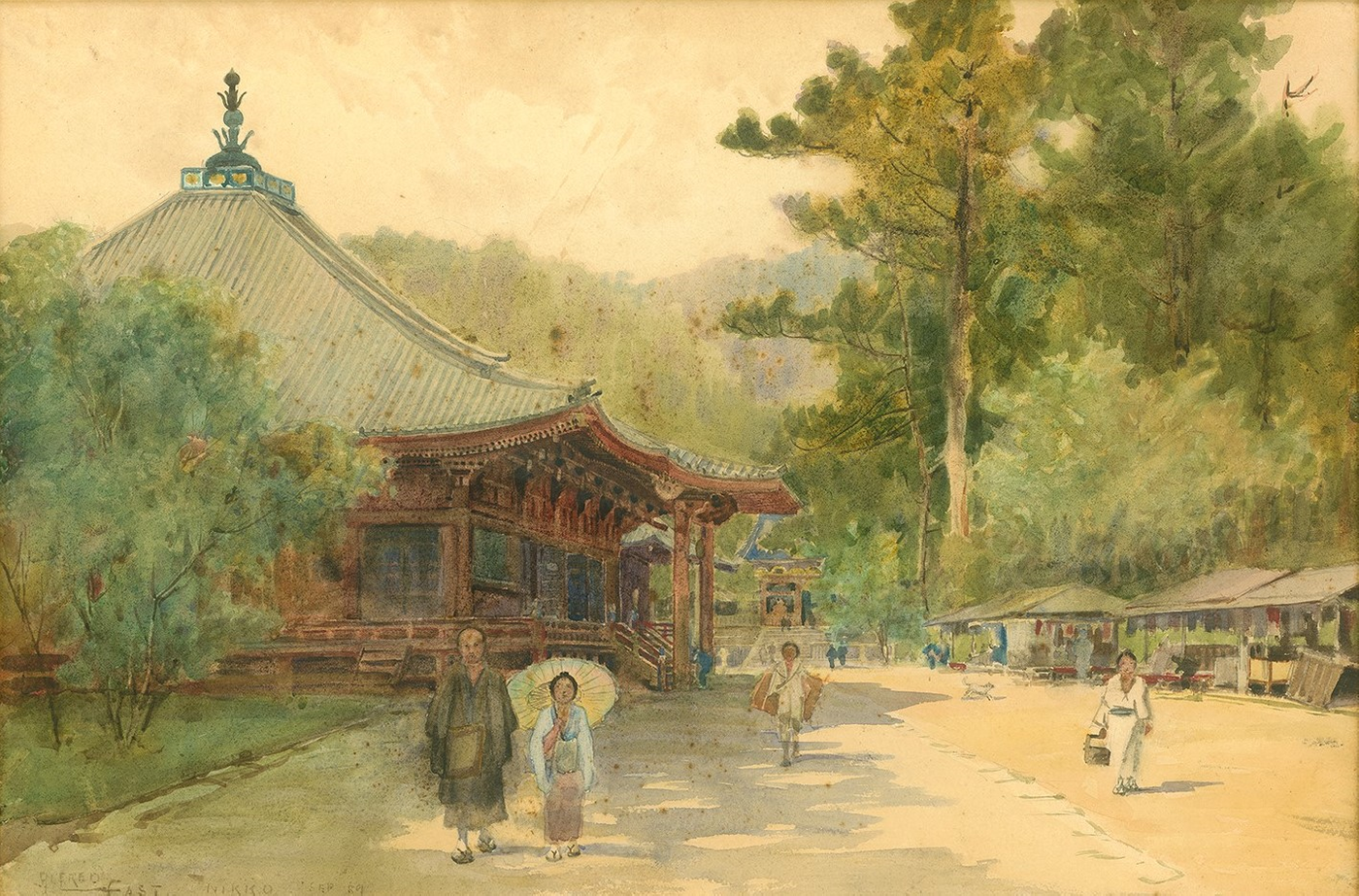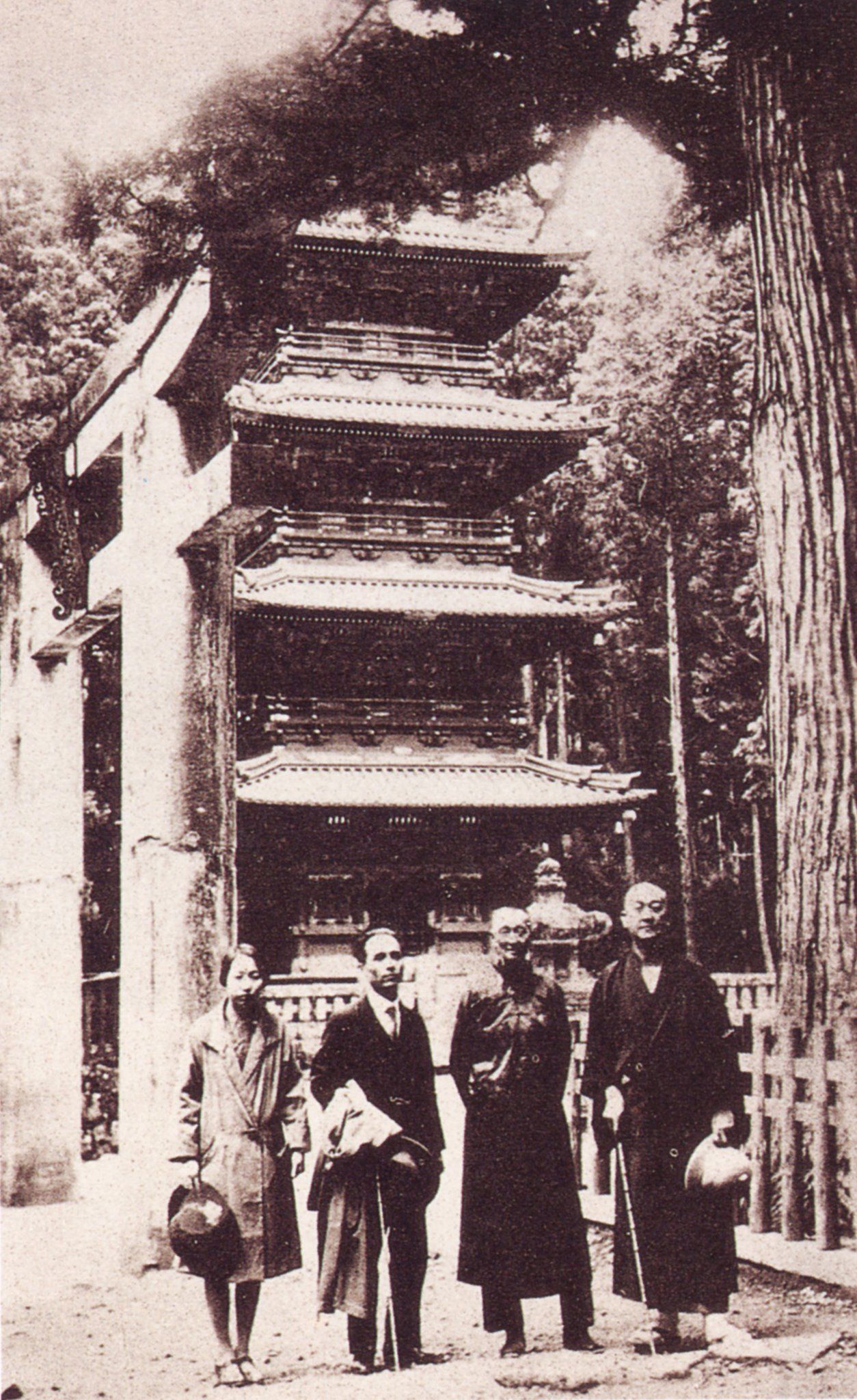
Facebook:https://www.facebook.com/ecthelion1993/ 美術史是研究美術品與時代文化交涉互動下的歷史研究,而當代讀者的閱讀及傳播也參與了美術史的形塑。五丁目期待透過不同形式的短篇筆記,提供關心文化、喜好藝術的各位一個富知識性的生活提案。
Sunlight Tour of Loess Water
Five-chome once introduced the stories and creations of British watercolor painter East, Japanese watercolor painter Ishikawa Kinichiro, and Chen Chengbo's master and apprentice who traveled to Nikko successively.
[Old text] Teachers and students walking in Nikko: East, Ishikawa Kinichiro and Chen Chengbo

However, as a famous scenic spot in Japan at that time, Nikko, located on the outskirts of Tokyo, is not only a must-visit place for Taiwanese students, but also a place that many tourists from overseas choose to visit when they travel.
In a black-and-white photo taken in the mid-1920s, the first Taiwanese sculptor to study in Japan, Huang Tushui (2nd from left), together with his wife (1st from left) and the abbot of Lingquan Temple in Keelung, Jiang Shanhui (1st from right), China Fuzhou-based Buddha statue sculptor Lin Qifeng (2nd from right) took a group photo in Nikko. Regarding the date of this photo, in Guo Yixuan’s master’s thesis (2014), it is believed that the shooting time was around 1925, which is the time when Jiang Shanhui went to Gushan, China to preach the precepts, and then went to Tokyo, Japan to attend the East Asian Buddhist Conference.

The location in the photo should be the five-story pagoda of Nikko Toshogu Shrine. The five-story pagoda was built by the famous Sakai family in the Edo period. The photo of this historic site is also one of the many postcard collections of painter Chen Chengbo, which shows the status of the five-story pagoda among many scenic spots in Nikko. The reason why the Huangtushui group chose the five-storied pagoda as the background for their group photo was because the Tang-style architectural appearance of the five-storied pagoda attracted Jiang Shanhui, who believed in Buddhism, and Lin Qifeng from China?

On the other hand, what is Loesshui's experience with the scenic spot of sunlight? Living in Tokyo to study sculpture and create, he must have visited this place earlier. Loess Shui mentioned in his 1923 article:
Maybe there are some outstanding paintings and sculptures in some hidden places in Taiwan, but not to mention foreign countries, even temples and Buddhist temples in Kyoto, Nara or Nikko must have some representative famous sculptures or paintings. On the contrary, I don't know much about it, and I am deeply saddened that there are no equivalent masterpieces on the whole island.
Loess Shui, who came from a carpenter family, is naturally familiar with the Buddha statues and architectural decoration art in Taiwanese temples, but he does not think that it is "real art". He traveled to Nara, Kyoto, Nikko and other famous ancient temples, and saw many ancient Japanese sculptures and paintings that have been preserved to this day, and was educated by Japanese and Western art at the Tokyo Art School. With a broad vision, he looks back at his hometown and believes that Taiwan lacks its own "inherent art" and only imitates and continues Chinese culture.
In 1924, Huangtushui was commissioned by the local gentry in Mengka to make Buddha statues for the rebuilding Longshan Temple. He referred to Liang Kai's "Sakyamuni Leaving the Mountain", a painter of the Southern Song Dynasty, who was valued in Japan. It took him many years to complete "Sakyamuni Leaving the Mountain" and was enshrined in the Mengka Longshan Temple. Does the statue of Mani also reflect his expectations for "Formosa Art"?
Looking back, maybe in 1925, I went to Nikko with Jiang Shanhui and his party to visit Toshogu Shrine, Lunwang Temple, and the loess water of the five-story pagoda. At the same time, I was thinking about the ideal "real art" that would be enshrined in Taiwanese temples.

References:
1. Guo Yixuan, "History and Artistic Expression of Lingquan Temple in Keelung during the Japanese Occupation", Master's Thesis, Institute of Art History, National Taiwan University, 2014.
2. "Taiwan Daily News", 1923-07-17 (Edition 7). For Chinese translation, refer to Yan Juanying's translation, "Landscape Mood: An Introduction to Taiwan's Modern Art Documents (Part 1)", Taipei: Lion, 2001, p. 131.
Like my work?
Don't forget to support or like, so I know you are with me..
Comment…